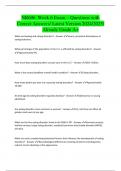NR606 Week 6 Exam – Questions with Correct Answers/ Latest Version 2024/2025/ Already Grade A+ What are feeding and eating disorders? - Answer ✔✔Severe, persistent disturbances in eating behaviors. What percentage of the population in the U.S. is affected by eating disorders? - Answer ✔✔Approximately 9%. How much does eating disorders cost per yea r in the U.S.? - Answer ✔✔$64.7 billion. What is the second deadliest mental health condition? - Answer ✔✔Eating disorders. How many deaths per year are caused by eating disorders? - Answer ✔✔Approximately 10,200. At what age do eating disorders typical ly develop? - Answer ✔✔Adolescence or young adulthood. Are eating disorders more common in women? - Answer ✔✔Yes, but they can affect all genders and races at any age. What are the five eating disorders listed in the DSM -5-TR? - Answer ✔✔Anorexia nervosa , bulimia nervosa, binge eating disorder, avoidant/restrictive food intake disorder (ARFID), and pica. What are some complex biopsychosocial factors that influence the development of eating disorders? - Answer ✔✔Neurobiological differences involving serot onin and dopamine, cultural norms idealizing a thin appearance. What are some risk factors for eating disorders? - Answer ✔✔Family history of eating disorders, weight stigma, trauma, history of being bullied about weight or appearance. What are some comm on characteristics of clients with eating disorders? - Answer ✔✔Negative self -appraisal, perfectionism, body image dissatisfaction, history of anxiety disorder. What is anorexia nervosa? - Answer ✔✔Eating disorder with restrictive eating patterns and low body weight. What percentage of the population does anorexia nervosa affect? - Answer ✔✔1 to 2%, including 0.3% of adolescents. What are the diagnostic criteria for anorexia nervosa? - Answer ✔✔Low body weight, fear of weight gain, disturbance in body we ight perception. What are the severity levels of anorexia nervosa based on BMI? - Answer ✔✔Mild (≤17 kg/m2), Moderate (16 -16.99 kg/m2), Severe (15 -15.99 kg/m2), Extreme (<15 kg/m2). What are the medical complications of anorexia nervosa? - Answer ✔✔Impact on major organ systems, risk of death due to starvation and suicide. What cardiovascular changes can occur in anorexia nervosa? - Answer ✔✔Decreased cardiac mass, reduced cardiac ch amber volume, mitral valve prolapse, myocardial fibrosis. When do pericardial effusions generally occur in anorexia nervosa? - Answer ✔✔With weight restoration. What are the functional changes associated with anorexia? - Answer ✔✔Bradycardia, hypotension , decreased diastolic ventricular function, diminished heart rate variability, QT interval prolongation. How does anorexia impact the gynecologic and reproductive system? - Answer ✔✔Secondary amenorrhea, decreased libido, increased incidence of pregnancy complications. What endocrine complications can occur with anorexia? - Answer ✔✔Hypothalamic -
pituitary abnormalities, severe bone loss. What gastrointestinal issues can arise from anorexia? - Answer ✔✔Gastroparesis, diarrhea or constipation, elevated liv er function tests, superior mesenteric artery syndrome, acute pancreatitis, gastroesophageal reflux disease, dysphagia. What renal and electrolyte imbalances can occur with anorexia? - Answer ✔✔Decreased glomerular filtration rates, difficulty creating co ncentrated urine, diuresis, hyponatremia, dehydration. What pulmonary complications can arise from anorexia? - Answer ✔✔Weakness and wasting of respiratory muscles, dyspnea, reduced aerobic capacity, decreased pulmonary capacity, aspiration pneumonia. What hematologic changes are common in anorexia? - Answer ✔✔Cytopenia, bone marrow changes, petechiae, purpura. What neurological conditions can be seen in anorexia? - Answer ✔✔Wernicke encephalopathy, Korsakoff syndrome, brain atrophy, other brain structur e changes. What are the dermatologic manifestations of anorexia? - Answer ✔✔Xerosis (dry, scaly skin), lanugo -like body hair, telogen effluvium (hair loss), carotenoderma (yellowing), acne, hyperpigmentation. Seborrheic dermatitis - Answer ✔✔Erythema and greasy scales on the skin Acrocyanosis - Answer ✔✔Cold, blue, and occasionally sweaty hands or feet





